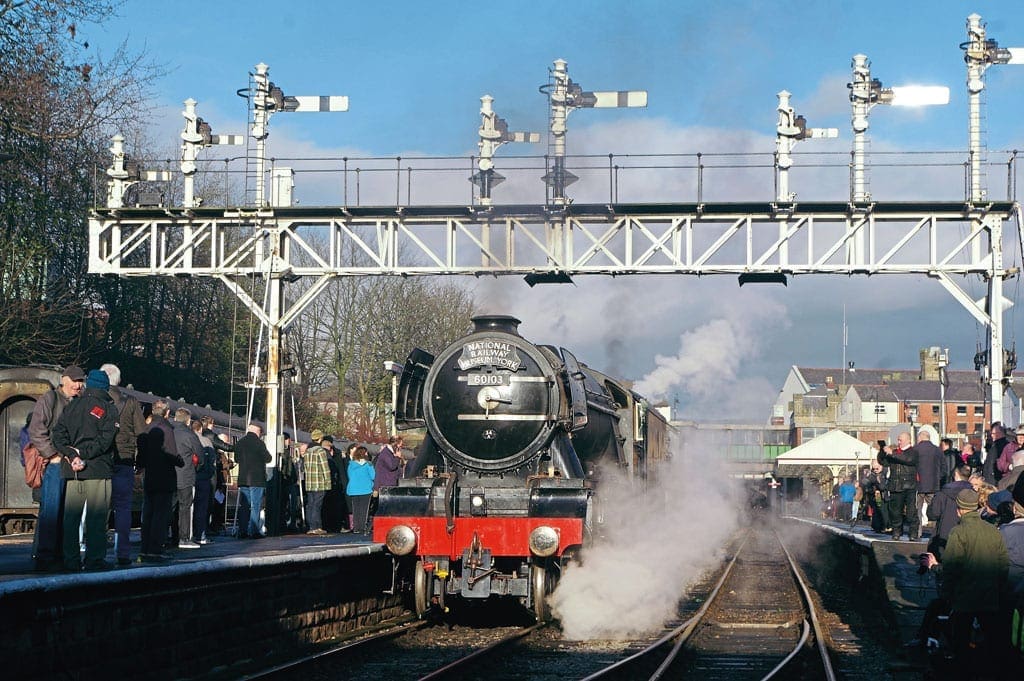
Words: Robin Jones
The year 2016 was unique in railway history. For it was the first time that Gresley A3 Pacific No. 60103 Flying Scotsman, the world’s most famous locomotive of the 20th century, was running at the same time as its 21st-century counterpart, new-build Peppercorn A1 Pacific No. 60163 Tornado.
Flying Scotsman’s fame was assured when the LNER publicity machine switched into overdrive in 1924, when it appeared at the British Empire Exhibition at Wembley, and again in 1928 when it hauled the first ‘Flying Scotsman’ named train nonstop from London to Edinburgh. And it lifted British engineering and transport technology to new dizzy heights in 1934 when it became the first in the world to be officially clocked at 100mph. And those feats were just for starters.
Since it emerged from Doncaster Works in 1923, Flying Scotsman has captured the imagination of people worldwide. It has become a defining icon of the Golden Age of Steam in the 1930s.
There are those who will say “yes, but what about Mallard and the 126mph world speed record in 1938?” Flying Scotsman never equalled the speed of the legendary A4, but as far as PR was concerned, it had a 14-year head start over No. 4468.


It beggars belief that Flying Scotsman so nearly ended up in a scrapyard in 1963, but for the efforts of businessman enthusiast Alan Pegler who bought it. And 41 years later, the perennial crowd-puller finally ended up where it should have been all along – back in public ownership, in the custody of the National Railway Museum.
Flying Scotsman, badly in need of significant repairs, was withdrawn from service at the end of 2005, and spent more than a decade, its longest period out of action in its illustrious history, being rebuilt.
Here, I recall the lines from American singer-songwriter Don McLean’s 1972 hit song American Pie:
“Oh and while the king (Elvis Presley) was looking down. The jester (Bob Dylan) stole his thorny crown
The courtroom was adjourned. No verdict was returned.”
While the King of Steam Flying Scotsman encompasses so much that there is to be proud about Britain, during its absence, a jester indeed arose literally out of nowhere, in the form of Tornado.
The saving of Flying Scotsman meant that the all-conquering A3 class did not pass into extinction. Sadly, the same could not be said for another East Coast Main Line classic, the Peppercorn A1, all 49 of which fell victim to the cutter’s torch.
There were those who remembered the class with affection, and decided to do far more than savour wistful memories of glories past. In true ‘back of a beermat’ style, they hatched a plan to build a new one, not just to run it at 25mph on heritage railways, but on the main line, in regular service.
And faced with a mountain range to climb to raise the necessary finance – £3 million – a lack of the steam workshops that regularly turned out locomotives for railway companies and the expertise employed there, and the need to adapt the design to meet the more exacting standards of the main lined network, they succeeded against overwhelming odds. The tenacity, drive and determination, ingenuity and resourcefulness of The A1 Steam.

Locomotive Trust again showed Britain in its finest hour, even though the boiler was built in Germany!
And yes, just like the LNER back in 1924, the trust has its own crack publicity machine, essential not only to support the colossal task of fundraising but to ensure growing public support for the ground-breaking project. In both cases, it passes with flying colours.
After it was launched in early 2009, the jester Tornado indeed stole the absent A3’s thorny crown. From its first main line trip, crowds turned out everywhere to see this gleaming new green celebrity, and even though the novelty of seeing the first steam locomotive built for the British main line since Evening Star in 1960 has by now worn off, with Tornado part and parcel of the modern heritage charter scene, the crowds have not quite dispersed yet.
However, unprecedented displays of fandom greeted the return of Flying Scotsman in January 2016, first in black livery for its test runs on the East Lancashire Railway, and then in BR Brunswick green back where it belongs, on the main line. Admirers have often packed every vantage point along its route, and sadly the T-word – trespass – a negative feature of its previous post-overhaul comeback runs in times past – has resurfaced. Following two incidents where the train and other east coast services were brought to a halt on its official relaunch from King’s Cross to York on February 25 followed by others, there have been incidents where train operators have rearranged its trips because of fears that spectators will ignore lineside fences – indeed, in these cases, it has become the locomotive that is too famous to run.

The highlight of 2016, however, was the meeting of both of these steam giants at the Severn Valley Railway’s Pacific Power event in September. It is estimated that at least 45,000 people turned out to see the pair in action, even though only a third of that figure were able to obtain tickets to ride, seats having sold out months before. The event, magnificently handled by the line’s management and their own superb publicity department, provided a unique platform for the finest of British steam engineering yesterday and today.
We are now in a new golden age of steam, one in which we can look forward to many more adventures involving these steam Titans, both on the national network and on heritage lines. And we look forward to the day when we will be able to see that long-promised line-up of east coast motive power – an A1, A2, A3 and A4. And there are now plans not only to run Tornado regularly at its design speed of 90mph, but also to provide it with its own dedicated train.
In building Tornado, The A1 Steam Locomotive Trust has laid down blueprints for other new-build projects to follow, and not content to rest on one magnificent achievement, is progressing with others. Its scheme to build the seventh example of an extinct Gresley classic, a P2 2-8-2, No. 2007 Prince of Wales, is now the world’s fastest-growing standard gauge new-build project, and it now has others in the pipeline.
You may also like…

The Skipton to Ilkley line was closed by Dr Beeching & reopened later as the Embsay & Bolton Abbey Steam Railway and has gone from strength to strength!


